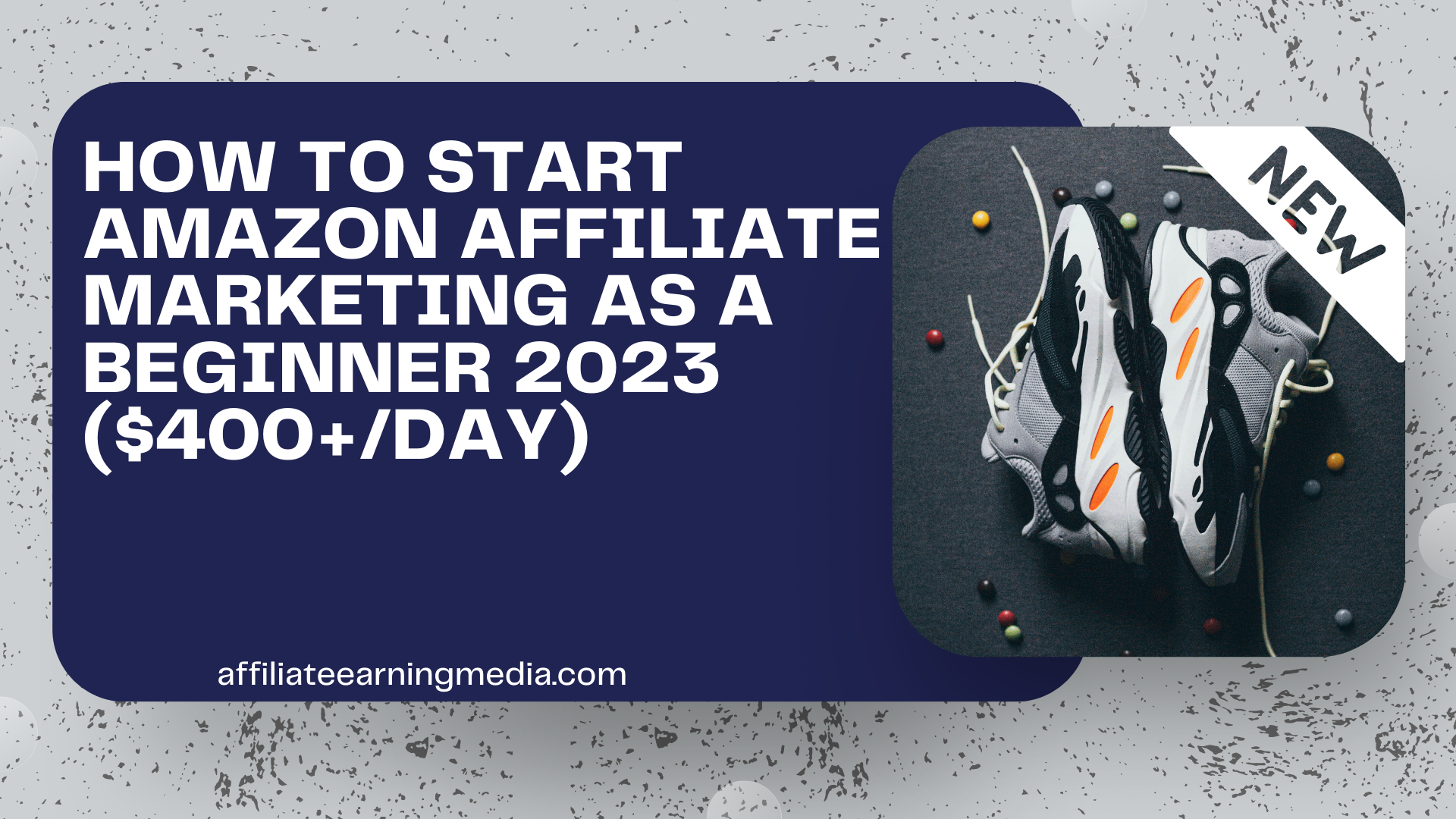In today’s digital age, affiliate marketing has emerged as a lucrative opportunity for individuals looking to earn passive income. Amazon Affiliate Marketing, in particular, has gained immense popularity due to its vast product range and trusted reputation. If you’re a beginner seeking to dive into this world and generate substantial earnings, here are five essential points to consider:
Best Recommended and Proven Way to Make Money Online – Watch this FREE Video to START >>

- Niche Selection: Choosing a profitable niche is crucial for the success of your Amazon Affiliate Marketing venture. Focus on a niche that aligns with your interests and has a large target audience. Conduct thorough research to identify high-demand products within your chosen niche. By selecting a niche that you are passionate about, you’ll be more motivated to create engaging content that resonates with your audience.
- Building a Website: Creating a professional website is fundamental to establishing your online presence. Choose a domain name that reflects your niche and is easy to remember. Opt for a reliable web hosting service and select a user-friendly content management system, such as WordPress. Design an aesthetically pleasing website that is easy to navigate, and ensure it is optimized for search engines. Your website should provide valuable content to visitors and effectively promote Amazon products.
- Content Creation: Quality content is the cornerstone of a successful affiliate marketing strategy. Produce engaging, informative, and valuable content for your target audience. Consider incorporating various formats such as product reviews, comparison articles, tutorials, and buying guides. Focus on providing unbiased and honest opinions to build trust with your readers. Use persuasive language and compelling visuals to entice visitors to click on your affiliate links.
- SEO Optimization: Search Engine Optimization (SEO) is essential to increase your website’s visibility and attract organic traffic. Conduct keyword research to identify relevant search terms related to your niche. Integrate these keywords naturally into your content, including titles, headings, and meta descriptions. Optimize your website’s loading speed, ensure mobile responsiveness, and use internal and external linking strategies. By implementing effective SEO techniques, you can improve your website’s ranking on search engine result pages.
- Promoting Your Affiliate Links: Once your website is up and running with quality content, it’s time to promote your affiliate links. Utilize various marketing channels such as social media, email marketing, and online communities to reach your target audience. Engage with your audience by responding to comments, queries, and reviews. Leverage the power of influencer marketing by collaborating with relevant influencers who can drive traffic to your website.
As a beginner in Amazon Affiliate Marketing, following these five key steps will provide a solid foundation for your success. Remember, building a profitable affiliate marketing business takes time, effort, and dedication. Be patient, consistently produce high-quality content, and continuously optimize your website for better performance. By implementing these strategies, you can generate substantial earnings and potentially reach the goal of earning $400 or more per day through the Amazon Affiliate Marketing program.
Niche Selection
Niche selection is the process by which organisms modify their environment in a way that benefits their own survival and reproduction. This can involve physical changes to the environment, such as building nests or dams, or it can involve changes to the chemical or biological makeup of the environment, such as the production of toxins or antibiotics.
Niche selection can have a number of important consequences for evolution. First, it can lead to the evolution of new adaptations. For example, if an organism builds a nest that provides better insulation, it will be more likely to survive in cold weather. This increased survival will lead to more offspring, and over time, the population will evolve to build better nests.
Second, niche selection can lead to the diversification of species. If two populations of a species live in different environments, they may evolve different ways of modifying their environments. This can lead to the evolution of two separate species, each with its own unique niche.
7 Points of Niche Selection
- Niche construction is a two-way process. Organisms modify their environment, but their environment also modifies them. This feedback loop can lead to rapid evolution.
- Niche construction can be both adaptive and maladaptive. Adaptive niche construction can help organisms to survive and reproduce in their environment. Maladaptive niche construction can actually harm organisms, but it can be difficult to distinguish between the two.
- Niche construction can be a powerful force for speciation. If two populations of a species live in different environments and modify their environments in different ways, they may evolve into separate species.
- Niche construction can have a significant impact on ecosystems. By modifying their environment, organisms can change the availability of resources, the distribution of competitors, and the abundance of predators. This can have a cascading effect on the entire ecosystem.
- Niche construction is an important area of research in evolutionary biology. By understanding how organisms modify their environment, we can better understand how evolution works.
- Niche construction has implications for conservation biology. By understanding how organisms modify their environment, we can better protect them from extinction.
- Niche construction is a complex and fascinating process. There is still much that we don’t know about it, but it is an important area of research that is sure to yield many new insights in the years to come.
Building a Website
Building a website can be a daunting task, but it doesn’t have to be. With a little planning and effort, you can create a website that is both informative and engaging.
Here are the 7 steps to building a website:
- Define your goals. What do you want your website to achieve? Do you want to generate leads, sell products, or simply share information? Once you know your goals, you can start to plan your website’s content and design.
- Choose a platform. There are many different platforms available for building websites, such as WordPress, Wix, and Squarespace. Each platform has its own strengths and weaknesses, so it’s important to choose one that is right for your needs.
- Buy a domain name and hosting. Your domain name is your website’s address on the internet, and hosting is the service that stores your website’s files and makes them accessible to visitors.
- Design your website. This is where you’ll get to put your creative juices to work. Choose a color scheme, fonts, and layout that will reflect your brand and appeal to your target audience.
- Create content. The content on your website is what will keep visitors coming back. Make sure your content is informative, engaging, and relevant to your target audience.
- Promote your website. Once your website is up and running, you need to let people know about it. Promote your website through social media, search engine optimization (SEO), and other marketing channels.
- Maintain your website. Once your website is live, it’s important to keep it up-to-date with fresh content and new features. You should also monitor your website’s traffic and analytics to see how it’s performing.
Content Creation
Content creation is the process of creating and sharing information or media content for specific audiences, particularly in digital contexts. It can take many forms, including blog posts, articles, videos, infographics, podcasts, and social media posts.
Best Recommended and Proven Way to Make Money Online – Watch this FREE Video to START >>
Content creation is an important part of any marketing strategy, as it can help to attract new customers, build relationships with existing customers, and boost brand awareness. It can also be a great way to share your knowledge and expertise with others.
If you’re new to content creation, here are a few things to keep in mind:
- Start with a clear goal in mind. What do you want to achieve with your content? Do you want to generate leads, increase sales, or simply share information? Once you know your goal, you can start to plan your content strategy.
- Choose the right format for your content. There are many different formats available, so choose one that is right for your audience and your message. For example, if you’re targeting a young audience, you might want to create videos or infographics. If you’re targeting a business audience, you might want to create blog posts or articles.
- Do your research. Before you start creating content, it’s important to do your research and understand your audience. What are their interests? What are their pain points? What kind of content do they consume? Once you understand your audience, you can create content that they will find valuable and engaging.
- Be consistent. One of the best ways to build an audience for your content is to be consistent with your publishing schedule. Try to publish new content on a regular basis, even if it’s just once a week.
- Promote your content. Once you’ve created your content, you need to let people know about it. Promote your content on social media, email marketing, and other channels.
- Measure your results. It’s important to track the results of your content creation efforts. This will help you to see what’s working and what’s not. You can use analytics tools to track things like website traffic, social media engagement, and leads generated.
SEO Optimization
SEO, or search engine optimization, is the process of making your website more visible in search engine results pages (SERPs). By optimizing your website for SEO, you can increase the amount of traffic that your website receives from search engines.
There are a number of things that you can do to optimize your website for SEO. Here are seven of the most important:
- Choose the right keywords. When people search for information on the internet, they use keywords. The keywords that you choose will determine how your website appears in search results.
- Use keywords throughout your website. Your keywords should appear in your website’s title tags, meta descriptions, headers, and body content.
- Create high-quality content. The content on your website should be high-quality and informative. This will help to attract visitors and keep them coming back.
- Build backlinks. Backlinks are links from other websites to your website. Backlinks are a signal to search engines that your website is authoritative and trustworthy.
- Optimize your images. Your images should be optimized for SEO. This means that they should have descriptive titles and alt text.
- Use social media. Social media can be a great way to promote your website and drive traffic to it. Share your content on social media and encourage your followers to share it as well.
- Track your results. It’s important to track the results of your SEO efforts. This will help you to see what’s working and what’s not. You can use analytics tools to track things like website traffic, search engine rankings, and backlinks.
Best Recommended and Proven Way to Make Money Online – Watch this FREE Video to START >>
Promoting Your Affiliate Links
Affiliate marketing is a great way to make money online. But how do you promote your affiliate links and get people to click on them?
Here are seven tips to help you promote your affiliate links:
- Create high-quality content. The best way to promote your affiliate links is to create high-quality content that people will want to read. This could be blog posts, articles, videos, or infographics. When you create high-quality content, you’ll attract visitors to your website or blog, and some of those visitors will click on your affiliate links.
- Use clear and concise language. When you promote your affiliate links, be sure to use clear and concise language. Don’t try to hide your affiliate links or make them seem like something they’re not. Be upfront about the fact that you’re an affiliate marketer and that you’re earning a commission if someone clicks on your link and makes a purchase.
- Use relevant keywords. When you’re promoting your affiliate links, be sure to use relevant keywords. This will help people find your content when they’re searching for information on the internet. You can use keyword research tools to find relevant keywords.
- Build backlinks. Backlinks are links from other websites to your website. Backlinks are a signal to search engines that your website is authoritative and trustworthy. When you build backlinks, you’re essentially telling search engines that other people think your content is valuable. This can help your website rank higher in search results, which will lead to more traffic and more clicks on your affiliate links.
- Use social media. Social media is a great way to promote your affiliate links. Share your content on social media and encourage your followers to share it as well. You can also use social media to run contests and giveaways that will help you promote your affiliate links.
- Run paid advertising campaigns. If you want to promote your affiliate links quickly, you can run paid advertising campaigns. Paid advertising campaigns can be a great way to reach a large audience, but they can also be expensive.
- Be patient and persistent. It takes time to see results from affiliate marketing. Be patient and persistent, and you will eventually see results.
I appreciate you reading my full article, How To Start Amazon Affiliate Marketing As A Beginner 2023 ($400+/Day)


